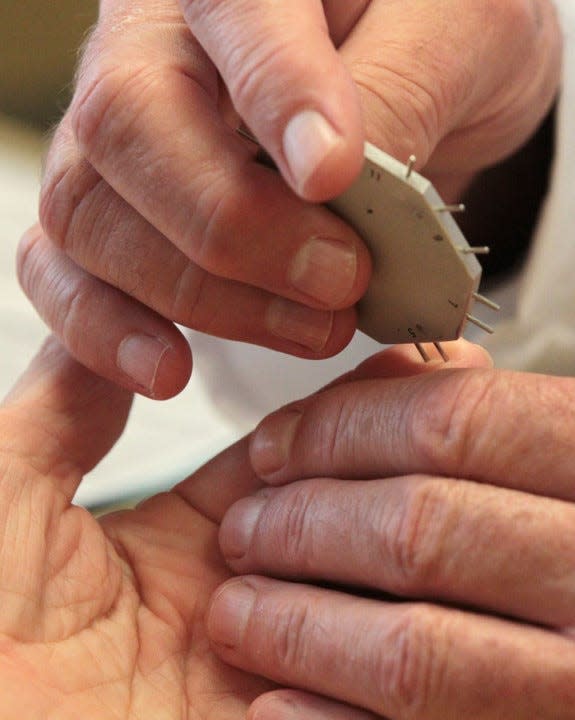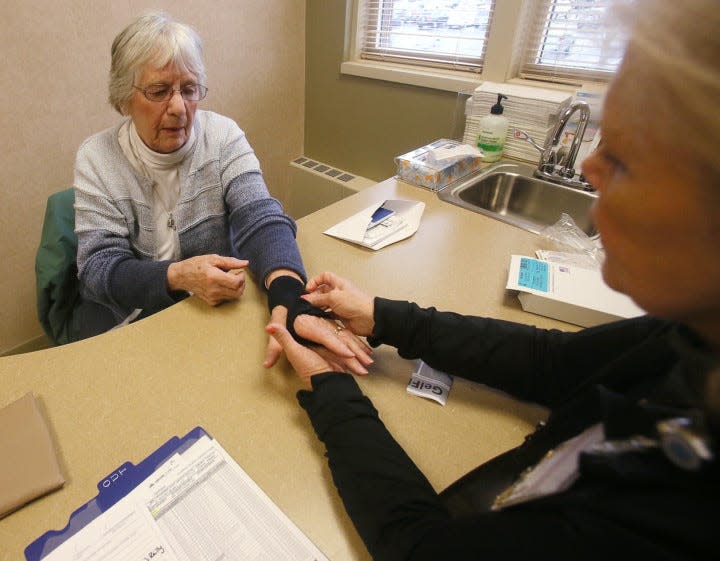Healthy Actions: How to recognize and avoid carpal tunnel syndrome
These days, so many of us are on desktop computers at work, or laptops.
All of that repetitive motion, without proper precautions or posture, can sometimes lead to carpal tunnel syndrome, a condition that causes numbness, tingling and other symptoms in the hand and arm.
This month's Healthy Actions topic is how to avoid carpal tunnel syndrome. My expert is Dr. T.J. Reilly, a hand surgeon at the Crystal Clinic Orthopaedic Center with 33 years experience.
Reilly, who trained in the Akron area, said in the 39 years since he was in medical school, he thought advances in medicine and education about precautions people could take would stamp out carpal tunnel.
But Reilly said he sees patients every day who have been at home with symptoms they didn't realize could be treated and, as a result, they could suffer permanent nerve damage. While Reilly can help them to minimize the symptoms, he may not completely take away the numbness.
“When you hear someone didn't do well with treatment for carpal tunnel, it's usually not bad surgery or wrong surgery, it was that they sat home thinking it wasn't a big deal and it ended up being irreversible nerve damage,” he said.

Carpal tunnel syndrome is caused by a compressed median nerve in the carpal tunnel, a narrow passageway on the palm side of your wrist.
That nerve goes to your thumb, index, middle and part of your ring finger.
Symptoms will usually start at night, or come on after repetitive use.
“It usually starts as tingling, numbness, pain, loss of dexterity, weakness,” Reilly said. “Rarely does the numbness extend above the wrist. It's normally in the hand, but you can get pain all the way up your arm and occasionally a tingly feeling.
“It can wake you up at night, where you have to shake your hand,” said Reilly, who added that it can be a similar tingling, pins-and-needles feeling to your arm falling asleep, but would be focused on your fingers.
The pain is always on the palm side. If you get numbness that goes up the arms, it's more likely coming from your neck, he said.
Carpal tunnel syndrome is more common in women than men, by about 3-to-1, and most of those women are between the ages of 45 to 65, Reilly said.
However, Reilly has diagnosed teens and patients in their 90s.
There are different reasons why carpal tunnel syndrome can occur, from anatomy of a smaller tunnel, repetitive use or hormonal contributions, he said.
“Women that are pregnant or just delivered can often have carpal tunnel symptoms,” Reilly said. “Women as they go through menopausal years can also have symptoms. Patients with low thyroid and diabetes can have symptoms.”
When to go to a doctor
Reilly said at the first signs of symptoms, get a wrist brace from a drugstore to hold your wrist perfectly straight while sleeping.
If the pain or numbness still persists, seek medical advice, first with your family physician, Reilly said.
Once Reilly, a specialist, sees a patient, if that person is still having symptoms despite splinting, he will do a physical exam and possibly a nerve test. That test can rule out a pinched nerve in the neck or nerve disease that would be rare, but could mimic carpal tunnel, he said.
Reilly discusses surgery if splinting, rest and other changes don't make it better.
He also discusses whether there is something obvious that the person is doing on the job or recreationally that could be adjusted.
Reilly has worked with factory workers in the past to adjust the ergonomics of their duties or work stations. Cake decorators who are squeezing icing tubes all day can even be at risk.
People who hyper-extend their wrists in yoga or who don't have proper form while exercising with kettlebells can be more prone to repetitive motion injuries, such as carpal tunnel syndrome, he said. Reilly doesn't suggest not doing those things, but just using caution.
Precautions
There are several things you can do to prevent developing carpal tunnel syndrome, Reilly said.
Wrist posture is very important. A flexed wrist posture, especially associated with repetitive gripping or finger motion, puts you at higher risk, he said.
Typing at a poor work station with wrists flexed at the keyboard is not good.
You want everything straight, Reilly said. You also don't want pinching at the elbows, wrist or neck.
In the 1980s and 1990s, more office work stations became ergonomic with split keyboards and drawers that came out and keyboard and mouse wrist rests to keep wrists straight and forearms on armrests to keep your arms at comfortable a 90-degree angle.
Keystrokes themselves do not significantly contribute to carpal tunnel. But Reilly does suggest getting up for occasional breaks.
“Posture is important. When you start your day, you're probably really sitting in a military posture. By the end of the day, a slouching posture is terrible for everything.”
Slouching on a couch while using laptops and tablets can also be a problem, Reilly said.
Surprisingly, Reilly said doctors have not seen an increase in problems from mobile phone texting or game-playing.
Reilly does not recommend sleeping on your wrist. He also suggests using a headset when you are on the phone to remove strain on your neck. People who wear cheater glasses or bifocals can also often get neck nerve problems since they are often looking up and extending their neck to look at the computer screen instead of looking straight ahead.

Reilly often ends up diagnosing patients with a combination of risk factors for carpal tunnel and neck issues. He may send the patient to a therapist for postural training and strengthening of the arm. But usually rest and posture changes are more important.
Sometimes a cortisone shot is helpful to decrease swelling.
If symptoms return, then surgery may be necessary.
Once a patient has surgery to release the carpal tunnel, the problem rarely returns, he said.
If you have an occasional tingling in your hands, that doesn't mean you'll need surgery.
“I think everyone has occasionally experienced carpal tunnel symptoms, after a long drive, or a long weekend pulling weeds or writing a term paper,” he said. “With carpal tunnel, you do not want to live with daily pressure on that nerve otherwise you're risking irreversible nerve damage.”
Medical writer Betty Lin-Fisher can be reached at 330-996-3724 or blinfisher@thebeaconjournal.com. Follow her @blinfisherABJ on Twitter or www.facebook.com/BettyLinFisherABJ and see all her stories at www.tinyurl.com/bettylinfisher
This article originally appeared on Akron Beacon Journal: Healthy Actions: How to recognize and avoid carpal tunnel syndrome

